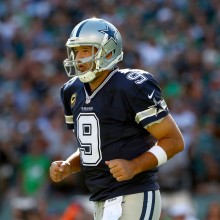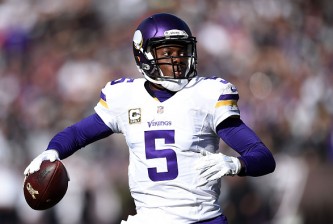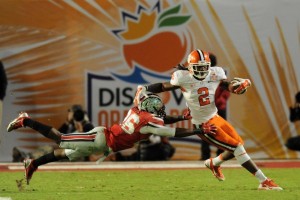The offensive side of the NFL Prototype Series is here.
Who’s the prototypical quarterback? What type of runner is the model back in today’s NFL? On the interior, who’s the best center?
Like with the Defensive Prototypes article, I tried to be very specific with different positions on the field, and I included 2014 rookies who are candidates to develop into prototypes in the future.
Quarterback: Aaron Rodgers, Green Bay Packers
OK…maybe to your grandpa or dad the “prototypical” quarterback is 6’5”, 240 pounds and statuesquely delivers rockets from the far hashmark on 20-yard out routes after rhythmic seven-step drops.
While that type of signal-caller still has a place in the league, today’s ideal quarterback is slightly different and more diversely talented.
In fact, the prototypical quarterback, Aaron Rodgers, is 6’2”, a deft pocket mover and scrambler. But, yeah, he most certainly can rip the 20-yard out from the far hash.
Green Bay’s gunslinger has been a mainstay near or at the top of Pro Football Focus’s Accuracy Percentage metric which measures a quarterback’s true ball placement by discounting drops, tipped passes, throwaways and hit-as-thrown releases.
He led the NFL with a laser-like Accuracy Percentage of 80.6 in 2011. In 2012, he again led the league with an AP of 80.2. Although he missed significant time with a shoulder injury last season, Rodgers was, for the third year in a row, the NFL’s most accurate passer. His AP was 79.3 on 290 attempts.
No quarterback has a more beautiful blend of athleticism, accuracy, arm strength, quick release and coverage-reading mastery.
In his last 40 regular-season games (starting in 2011), Rodgers has thrown 101 touchdowns to a minuscule 20 interceptions and his career QB Rating is 104.9, the highest in NFL history.
Candidate From 2014 Draft Class: Teddy Bridgewater, Minnesota Vikings
This one’s easy. Teddy Bridgewater is around Aaron Rodgers’ size, has a similar, quick-snap release, sharp accuracy and some mobility to move out of the pocket in certain situations.
Like Rodgers, Bridgewater fell in Round 1, to some, rather inexplicably because of the handful of squeaky clean performances he put on film at Louisville.
In an offense with Adrian Peterson, Greg Jennings, Cordarrelle Patterson, Kyle Rudolph and a solid offensive line, Bridgewater’s ascension to stardom could happen relatively fast.
Running Back: Andre Ellington, Arizona Cardinals
I haven’t factored in draft position much in this series, but for the running back spot, it’s fitting. They’ve been devalued so much in today’s spread ’em out, pass-centric NFL — teams are waiting longer and longer to draft them.
Also, teams are slowly but surely moving away from the lumbering, North-South powerbacks and incorporating smaller, quicker and faster speedbacks with pass-catching familiarity.
For the most part, gone are the days of the 30-carry-per-game “feature” backs. Today’s “feature” back might reach 20-25 touches per outing, an important difference. Running back committees rule the NFL landscape, too. They help to maintain efficiency and prolong careers.
Andre Ellington was a sixth-round pick out of Clemson in 2013.
At 5’9″ and 199 pounds, he was viewed as a “change of pace” or “third-down” runner.
As a rookie, he was the most efficient back in the league. Ellington averaged a robust 5.5 yards per carry on 118 rushes and he caught 39 passes for 371 yards.
The 25 year old is precisely the type of running back built for the present and future of the NFL. Everything from when he was drafted, to his size, to his quick-twitch athleticism and receiving ability.
Candidate From 2014 Draft Class: Lache Seastrunk, Washington Redskins
At 5’9″ and 201 pounds at the combine, Lache Seastrunk is built comparably to Andre Ellington. Both ran in up-tempo, spread offenses in college and produced more in space and on the outside than they did in tight spaces near the center.
Leastrunk has 4.51 speed, modern “airback” shiftiness in the open field and the acceleration needed to zoom around the corner to hit top gear near the sidelines.
With Alfred Morris and Roy Helu Jr. ahead of him in Washington, it might be difficult for Seastrunk to get a considerable amount of carries, but no one expected Ellington to emerge in the Arizona Cardinals backfield a season ago, either.
Outside Wide Receiver: Calvin Johnson, Detroit Lions
The Football Gods had fun when they created Calvin Johnson. The 6’5″, 240-pound monster with 4.4 speed is, quite easily, the NFL’s prototypical wide receiver.
Appropriately nicknamed “Megatron,” Johnson can do everything you’d ever ask of a wideout.
He led the NFL in receiving yards in 2011 and 2012, the latter being the year in which he recorded 122 grabs for 1,984 yards.
Though Johnson saw a dip in production in 2013, he still made 84 receptions for 1,492 yards with 12 touchdowns and posted a yards-per-catch average of 17.8, the highest of his illustrious career.
Candidate From 2014 Draft Class: Mike Evans, Tampa Bay Buccaneers
He doesn’t possess the otherworldly speed-size combination of Calvin Johnson, Mike Evans measured in at 6’4″, and 231 pounds at the combine. He ran a 4.53 in the 40 and flashed a 37-inch vertical.
This Texas A&M star was Johnny Manziel’s go-to target in College Station over the past two years. In 2013, Evans averaged 20.2 yards per catch en route to a 1,394-yard, 12-touchdown masterpiece.
Though not an amazingly effective YAC wideout, he rarely, if ever loses a jump ball situation and has tremendously strong hands.
This boundary receiver is the closest specimen to Megatron from the 2014 class.
Possession Slot Receiver: Wes Welker, Denver Broncos
Since his emergence with the New England Patriots in 2007, Wes Welker has been the ideal possession slot receiver. It’s that simple. Heck, every small and quick slot receiver gets compared to him.
Welker’s as pesky as they come, and although he’s struggled with some drops, when he’s healthy, no one’s better.
The former Texas Tech Red Raider cannot be covered in one-on-one situations and his crisp route-running and surprising touchdown-scoring prowess has made him a borderline Hall of Fame candidate.
Since that memorable 2007 campaign, Welker’s averaged 106 catches for 1,176 yards and 6.7 touchdowns per season.
Candidate From 2014 Draft Class: Jarvis Landry, Miami Dolphins
Although Odell Beckham Jr. was the No. 12 overall choice in the 2014 draft, if you watch LSU film from either of the past two seasons, Jarvis Landry was, arguably, just as impressive on the field.
He has ultra reliable hands, routinely creates separation with sudden cuts and speed changes, and he definitely showed the flair to make the circus grab in tight coverage.
Landry’s not a burner by any stretch, but from the slot, he’ll win the majority of his one-on-one matchups, and even if he doesn’t, he’ll come down with the football more often than not.
Speed Slot Receiver: T.Y. Hilton, Indianapolis Colts
T.Y. Hilton spent more than half of his second NFL season on the outside, not in the slot, per Pro Football Focus. However, with Reggie Wayne coming off his ACL tear and Hakeem Nicks now in the fold with the Colts, expect the former Florida International University spark plug to line up on the inside more often in 2014.
Many wideouts spend more of their time in the slot than Hilton, but the fiery, 5’10” pass-catcher makes the most the most of his snaps there.
According to Pro Football Focus, DeSean Jackson was the only sub-6’0″ receiver who had a higher yards-per-route-run average out of the slot last year than Hilton’s 2.20.
After Wayne’s injury, the 2012 third-rounder played the role of Indianapolis’ possession receiver—hence the major uptick in receptions (82) but decrease in yards-per-catch (13.2) from his 50-grab, 862-yard rookie campaign.
With weapons around him on the outside, Hilton will continue to make explosive plays down the field on passes from developing signal-caller Andrew Luck in Pep Hamilton’s offense.
Candidate From 2014 Draft Class: Brandin Cooks, New Orleans Saints
Brandin Cooks is just shy of 5’10” and weighs 190 pounds with scintillating 4.33 speed and Tavon Austin-like agility. Stronger than his size suggests, Cooks could, theoretically, line up on the outside against larger cornerbacks.
However, expect the New Orleans Saints to use him in somewhat of an advanced Darren Sproles capacity.
Off the line, he’ll be able to leave nickel cornerbacks in the dust most of the time, but don’t be shocked if he’s used to stretch the seam along with Kenny Stills.
Cooks snagged 128 passes for a Division I-leading 1,730 yards with 16 touchdowns during his last season at Oregon State.
Oh, and he won’t be 21 until September 25.
Creative, YAC, Screen Receiver: Percy Harvin, Seattle Seahawks
The last two years of Percy Harvin’s football career haven’t been very fun. He dealt with nagging leg injuries, had disagreements with his coaches in Minnesota, and after he was traded to the Seattle Seahawks, a hip ailment limited him to just one regular season game and one reception for 17 yards in 2013.
When the former Florida Gators stud is 100 percent, he’s the exemplary gadget/screen/YAC wideout.
In 2010, he finished third in the NFL among wideouts who played at least 50 percent of their respective teams snaps with 6.4 YAC per reception, per Pro Football Focus. In 2011, only Victor Cruz and Julio Jones were more effective after the catch than Harvin, whose YAC-per-reception average jumped to 7.1. The next year, though plagued by injuries, he actually led the NFL with a whopping average of 8.7 YAC-per-reception.
Harvin was a hybrid receiver-running back with the Gators, and the Vikings certainly accentuated his talents by featuring him as that type of player to begin his pro career.
In 2014 with the Seahawks, the sky is the limit for the electric speedster who just turned 26.
Candidate From 2014 Draft Class: Sammy Watkins, Buffalo Bills
At 6’1″ and 211 pounds, Sammy Watkins is bigger than 5’11”, 200-pound Percy Harvin, but their games are eerily similar and comparably dangerous to opposing defenses.
Watkins used a unique fusion of blistering 4.41 speed, rocketing burst, nifty lateral movement and deceptive power to stake his claim as college football’s most threatening and exciting offensive position player.
At just 20 years of age, the Clemson star caught 101 passes for 1,464 yards and 12 touchdowns, and the majority of his yardage came after the catch.
Watkins is a larger, more strong-handed version of Harvin, which isn’t good news for NFL defensive coordinators.
Pass-Catching Tight End: Jimmy Graham, New Orleans Saints
In hopes of getting paid more money, Jimmy Graham’s been fighting to be officially considered a wide receiver. But for the sake of this article, he’s a tight end.
With 4.56 speed at 6’6″ and 260 pounds with ACC-caliber basketball athleticism, it’s not hard to realize how difficult it is for linebackers, cornerback or safeties to match up with the New Orleans Saints pass-catcher down the seam and in the red zone.
Graham has averaged 90 receptions, 1,169 yards and 12 touchdowns over the past three seasons.
He’s the tight end every other NFL team is trying to uncover when they give tryouts to former Division I basketball players.
Candidate From 2014 Draft Class: Jace Amaro, New York Jets
Eric Ebron was probably who you expected here, but Jace Amaro’s size and unheralded speed make him more likely to become a Jimmy Graham-type tight end in the NFL.
Running a 4.74 at the combine at 6’5″ and 265 pounds was darn impressive, and he received plenty of experience catching the ball in Texas Tech’s wide open offense during his collegiate career.
Though not as springy of athlete as Graham — not many are — Amaro has the enormous frame, YAC ability and movement skills to make a huge impact with the Jets early in his career.
Complete Tight End: Rob Gronkowski, New England Patriots
When healthy — which hasn’t been often during the past two years — Rob Gronkowski is the perfect NFL tight end. Seriously.
He’s a mammoth 6’7″ and nearly 270 pounds and can be used in a variety of ways.
Gronk’s pass-catching productivity was the reason he rose to immense fame, and deservedly so. After 10 touchdown snags as a rookie in 2010 and an outrageous 17 scores in 2011, accolades were sure to follow. He was an All-Pro in his second season.
What can get overlooked with this monstrous tight end is his run-blocking expertise. Gronkowski can be downright dominating in-line paving the way for running backs.
In 2010, he was Pro Football Focus’ 5th-ranked run-blocking tight end. The next year, he was the best.
Injuries have derailed his legendary career trajectory, but still, Gronkowski is the model, all-round tight end.
Candidate From 2014 Draft Class: Troy Niklas, Arizona Cardinals
Troy Niklas is still raw, having started his Notre Dame career as a defensive lineman, but at 6’6″ and 270 pounds at the age of 21, from a physical perspective, he has a very bright future.
Don’t peg Niklas as a heavy-footed, limited athlete, either.
He moves his enormous body relatively well and displayed some ability to high-point the football in the red zone. With the Fighting Irish, Niklas played in-line often and is already a strong and capable blocker.
If he continues to progress as a football player, we’re looking at the next Gronkowskian figure in the NFL.
Offensive Tackle: Joe Thomas, Cleveland Browns
You don’t hear about Joe Thomas very much, do you? For an offensive lineman, that’s a good thing. See defender. Block him. Repeat.
The No. 3 overall pick in the 2007 draft has simply gone about his business in Cleveland for seven years now and has been rewarded with seven Pro Bowl distinctions and All-Pro honors in each of the past four seasons.
The 6’7″, 310-pound Wisconsin product is a super sturdy pass-blocker and rebounded to receive a positive Pro Football Focus run-blocking grade in 2013 after a “down” year in that regard in 2012.
Every offensive tackle should strive to be the Browns’ Joe Thomas.
Candidate From 2014 Draft Class: Taylor Lewan, Tennessee Titans
Greg Robinson may eventually play either left or right tackle with the St. Louis Rams, but for now, he’s penciled in at left guard next to Jake Long.
Because of that, Taylor Lewan gets the nod here, a nod he certainly deserves.
The Michigan star is 6’7″ and 310 pounds with years of sound play in the Big 10 on his resume.
He’s a plus athlete for his size who possesses fantastic fundamentals and inherent strength to stymie bull rushers and push many defenders backward.
He has Joe Thomas size and a similar blue-collar, Big 10 pedigree.
Offensive Guard: Evan Mathis, Philadelphia Eagles
The best guard in the NFL is Evan Mathis. No ands, ifs or buts. Pro Football Focus Steve Palazzolo mentioned this offseason that Mathis isn’t a flashy “road-grader,” but that doesn’t mean he’s ineffective. He effortlessly blocks everyone in his path.
That’s perfect analysis.
The Philadelphia Eagles star has been Pro Football Focus’ top-ranked guard in each of the last three seasons…by wide margins.
When watching his film, you’ll see a large, incredibly nimble man who, in a very controlled manner, simply moves everyone he comes into contact with at every level of the field and rarely gets pushed into the quarterback.
He’s LeSean McCoy’s best friend on the field.
Candidate From 2014 Draft Class: Greg Robinson, St. Louis Rams
While Evan Mathis is a smooth, fluid blocker, Greg Robinson is a downright mauler who physically overwhelms defensive linemen and linebackers alike.
Men 6’5″ and 325 pounds shouldn’t be able to drive their legs as quickly as Robinson does, and he plays with a extremely noticeable nasty streak.
He’ll be a run-blocking animal wherever he lines up, but inside at guard, he’ll open big lanes for Zac Stacy and Tre Mason in St. Louis.
Center: John Sullivan, Minnesota Vikings
Who? Yes, John Sullivan…another relatively unknown yet elite offensive lineman. While Alex Mack, Nick Mangold, and Chris Myers are a few of the more identifiable centers in the NFL, the Minnesota Vikings center is the prototypical pivot.
He was Pro Football Focus’ highest-graded center in 2012 and finished 3rd in 2013.
Sullivan was a lowly sixth-round choice out of Notre Dame in 2008 and wins with amazing spatial awareness, movement skills and leverage despite being 6’4″ which is slightly taller than the average NFL center.
Candidate From 2014 Draft Class: Weston Richburg, New York Giants
A smart, bulky and fleet-footed center, Weston Richburg was born to play on the New York Giants offensive line and follow former stars like Chris Snee and Shaun O’Hara.
On the inside for the G-Men, Richburg will call out protections, locate blitzers and help with double teams when he’s not locking up the opposition’s nose tackle.
He plays with outstanding leverage and gets to the second level as an under control battering ram often.

























-300x200.jpg)

-300x213.jpg)